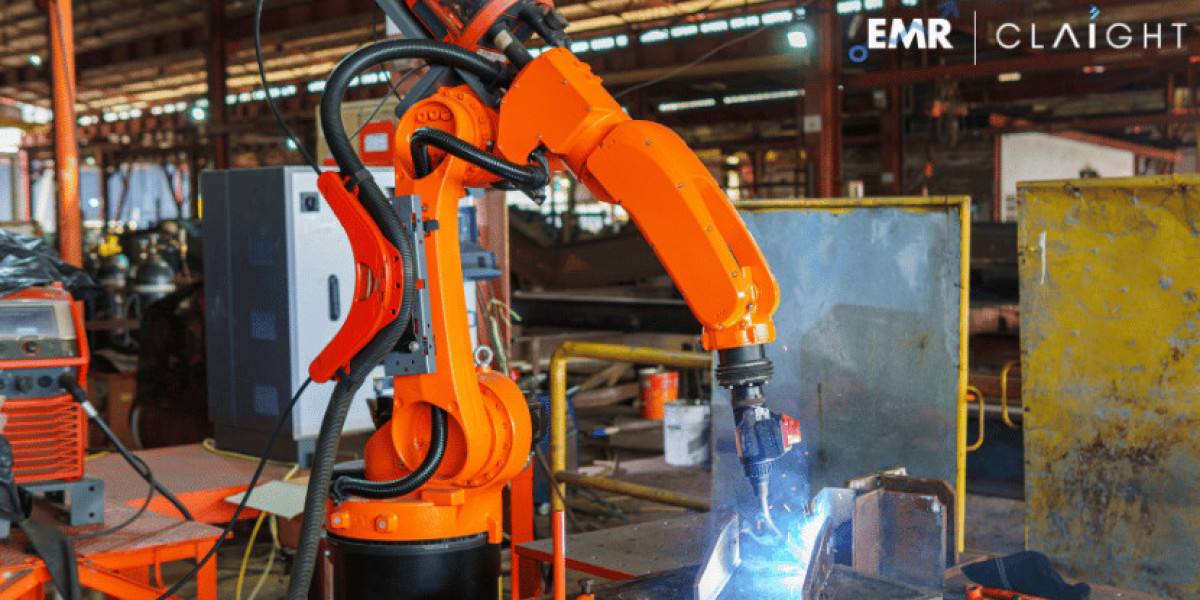Robotic Welding Market Outlook
Robotic welding is a crucial aspect of modern manufacturing, providing efficient, high-quality, and consistent welding solutions across various industries. The global robotic welding market has gained significant momentum, with its size reaching approximately USD 4,501.10 million in 2023. This growth is expected to accelerate, with projections indicating a Compound Annual Growth Rate (CAGR) of 8.0% from 2024 to 2032, ultimately reaching around USD 9,192.65 million by 2032. This report delves into the factors driving this market growth, key players, market segmentation, and future trends shaping the industry.
Market Size and Growth
The robust growth of the robotic welding market can be attributed to several factors:
Increased Industrial Automation: Industries are increasingly adopting automation to enhance productivity, reduce labor costs, and improve quality. Robotic welding is at the forefront of this automation trend, particularly in sectors such as automotive, aerospace, and heavy manufacturing.
Advancements in Robotics Technology: Innovations in robotics, such as improved sensors, artificial intelligence (AI), and machine learning (ML), have enhanced the capabilities of robotic welding systems, making them more efficient and versatile.
Rising Demand for High-Quality Welds: Industries are focusing on quality and precision in their manufacturing processes. Robotic welding offers superior accuracy and repeatability, reducing defects and ensuring higher quality products.
Get a Free Sample Report with Table of Contents@ https://www.expertmarketresearch.com/reports/robotic-welding-market/requestsample
Key Market Statistics
- Market Size (2023): USD 4,501.10 million
- Projected Market Size (2032): USD 9,192.65 million
- CAGR (2024-2032): 8.0%
Key Companies in the Market
The robotic welding market is characterized by the presence of several prominent players that contribute to its growth through innovation, strategic partnerships, and expansion of their product portfolios. The major companies in this sector include:
Fanuc Corporation
- A global leader in industrial robotics, Fanuc offers a wide range of robotic welding solutions, known for their reliability and efficiency.
ABB Ltd.
- ABB is recognized for its advanced robotic technologies and comprehensive automation solutions, enhancing productivity in various industries.
Yaskawa Electric Corporation
- Yaskawa specializes in industrial automation and robotics, providing innovative welding solutions that meet the needs of modern manufacturing.
Kuka AG
- Kuka is a key player in the robotics market, offering a range of robotic systems, including those designed specifically for welding applications.
EVS TECH CO., LTD
- EVS TECH focuses on advanced welding technology and robotic solutions, catering to diverse industrial needs.
Estun Automation Co., Ltd.
- Estun Automation is known for its innovative robotic systems and automation solutions, playing a significant role in the robotic welding market.
NACHI-FUJIKOSHI CORP.
- NACHI offers advanced welding robots and automation systems, contributing to the efficiency and precision of welding processes.
Panasonic Corporation
- Panasonic provides a range of robotic welding solutions, known for their high performance and integration capabilities.
Market Drivers
Increasing Demand for Automation
The global manufacturing landscape is undergoing a transformation, with businesses increasingly turning to automation to enhance operational efficiency. Robotic welding is a critical component of this shift, as it allows for:
- Reduced Labor Costs: Automation minimizes the need for manual labor in welding processes, significantly lowering labor expenses.
- Increased Production Speed: Robotic systems can operate continuously and at high speeds, resulting in faster production cycles.
- Improved Flexibility: Robotic welding systems can be programmed for various tasks, enabling manufacturers to adapt quickly to changing production needs.
Technological Advancements
The integration of advanced technologies into robotic welding systems has been a game-changer. Key technological advancements include:
- Artificial Intelligence and Machine Learning: AI and ML enhance the adaptability and decision-making capabilities of robotic systems, allowing them to optimize welding processes in real-time.
- Enhanced Sensors and Vision Systems: Improved sensors enable robots to perceive their environment better, facilitating more precise and accurate welding operations.
- Robust Software Solutions: Innovative software platforms streamline the programming and integration of robotic systems into existing workflows, making deployment easier and more efficient.
Quality and Consistency
The demand for high-quality and consistent welding is paramount in industries where safety and reliability are critical. Robotic welding systems provide:
- Precision Welding: Robots can execute complex welding tasks with remarkable accuracy, ensuring consistent weld quality.
- Minimized Defects: The reduced variability in robotic processes leads to fewer defects and higher product quality, which is especially important in sectors like automotive and aerospace.
Market Segmentation
The robotic welding market can be segmented into various categories to better understand its dynamics:
By Type
Arc Welding Robots
- Description: Utilizes electric arcs to melt and fuse metals together.
- Applications: Predominantly used in the automotive industry and other sectors requiring high-volume production.
Spot Welding Robots
- Description: Employs localized heat to join metal surfaces.
- Applications: Commonly used in the automotive assembly line for joining sheet metal parts.
Laser Welding Robots
- Description: Uses focused laser beams for precision welding without causing distortion.
- Applications: Gaining traction in industries requiring high precision and minimal heat-affected zones.
By End-User
Automotive Industry
- The largest consumer of robotic welding technology, focused on enhancing assembly line efficiency.
Aerospace
- Requires high-quality welds for safety and structural integrity in aircraft manufacturing.
Consumer Electronics
- Increasingly adopting robotic welding for assembling electronic components and devices.
Construction
- Utilizes robotic welding for structural steel fabrication, enhancing efficiency and quality.
By Region
North America
- Description: Dominates the market due to a strong presence of automotive and aerospace industries.
- Trends: Advanced manufacturing technologies and a robust regulatory environment support market growth.
Europe
- Description: Significant growth driven by technological advancements and high adoption rates in countries like Germany and France.
- Trends: Strong focus on innovation and efficiency across various manufacturing sectors.
Asia-Pacific
- Description: Expected to witness the highest growth due to rapid industrialization and increased manufacturing activities in countries like China and India.
- Trends: Growing investment in automation technologies is reshaping the manufacturing landscape.
Latin America and Middle East & Africa
- Description: Slower growth compared to North America and Europe, but with increasing adoption of robotic welding solutions.
- Trends: Focus on improving healthcare systems and conducting more industrial activities drives market growth.
Competitive Landscape
The robotic welding market is characterized by intense competition among key players striving for innovation and market share. Companies employ various strategies to maintain their competitive edge:
Innovation and Product Development
Leading companies are continuously investing in research and development to innovate and improve their robotic welding solutions. For example:
- Fanuc Corporation invests significantly in AI and machine learning to enhance the capabilities of its robotic systems.
- ABB Ltd. focuses on developing advanced welding solutions that integrate seamlessly with other automation systems.
Strategic Partnerships and Collaborations
Strategic alliances between companies and research institutions play a vital role in driving innovation and market expansion. For instance:
- Partnerships between robotic manufacturers and software developers can lead to the creation of more advanced and user-friendly welding solutions.
- Collaborations with educational institutions help in training the next generation of engineers skilled in robotic automation.
Mergers and Acquisitions
Mergers and acquisitions are common in the robotic welding market as companies seek to expand their product offerings and market reach. This strategy allows firms to leverage synergies, acquire new technologies, and gain access to new customer bases.
Future Trends and Opportunities
Integration of AI and Robotics
The future of robotic welding is likely to be heavily influenced by the integration of AI and robotics. As AI technology evolves, robotic systems will become more capable of self-learning and adaptation, allowing for improved efficiency and reduced downtime.
Expansion into Emerging Markets
As economies in Asia-Pacific and Latin America continue to grow, the demand for robotic welding solutions will rise. Companies that establish a presence in these emerging markets will benefit from increased manufacturing activities and a growing need for automation.
Customization and Flexibility
Manufacturers are increasingly seeking customizable robotic welding solutions that can adapt to diverse production requirements. Companies that offer flexible, modular systems will likely gain a competitive advantage.
Decentralized Manufacturing
The trend towards decentralized manufacturing is expected to influence the robotic welding market. With the rise of smart factories and Industry 4.0, companies are looking for solutions that can be easily integrated into decentralized production networks.
Media Contact:
Company Name: Claight Corporation
Contact Person: Eren smith, Corporate Sales Specialist – U.S.A.
Email: sales@expertmarketresearch.com
Toll Free Number: +1-415-325-5166 | +44-702-402-5790
Address: 30 North Gould Street, Sheridan, WY 82801, USA
Website: https://www.expertmarketresearch.com






